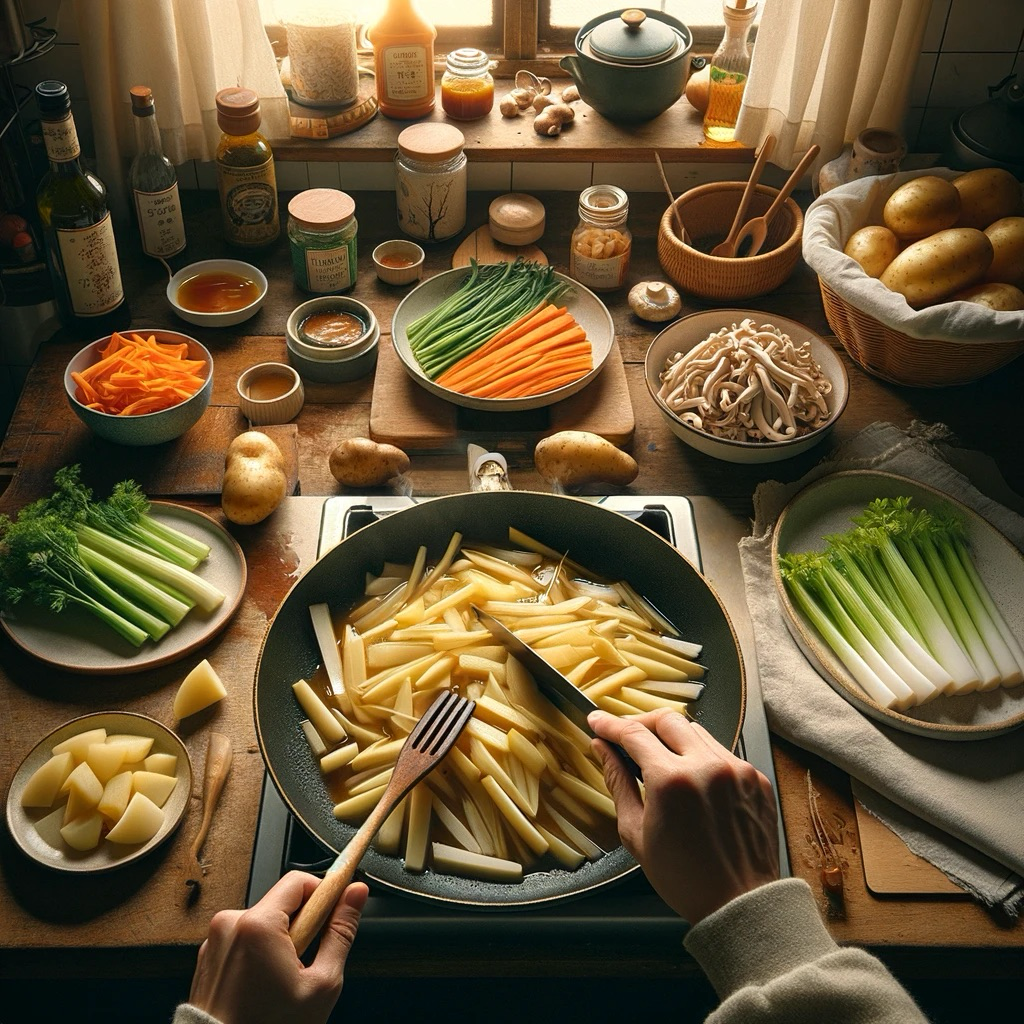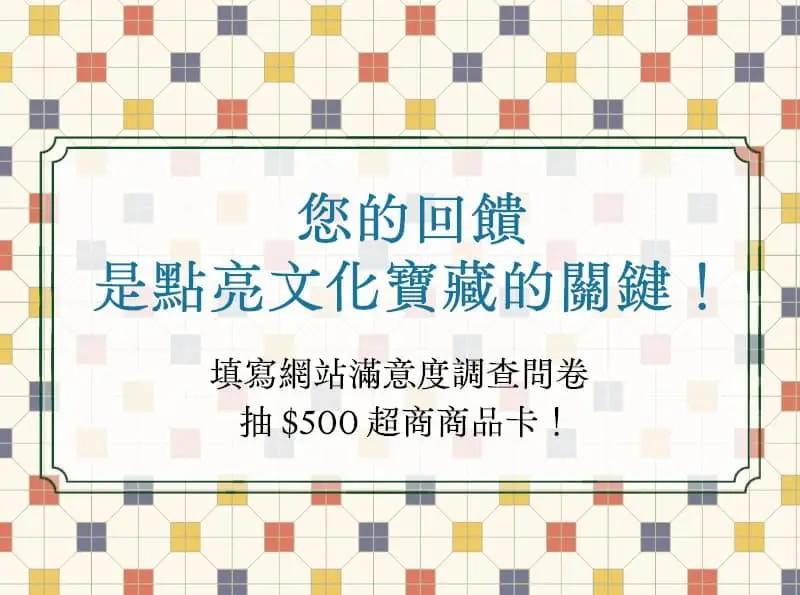很久沒有吃家常菜,非常想吃米飯配現炒的菜,剛好天氣不錯,決定下樓走走順便去買食材,到樓下按著熟悉的路線抵達了頂好超市,自動門打開了,冷氣撲面而來,吹去了有點煩躁的情緒,拿上購物籃,走到冷藏蔬菜去,一排又一排,尋找著需要的蔬菜,拿了一把翠綠的芹菜,又看到旁邊有胡蘿蔔和金針菇也各拿了一帶,心中決定好要做的菜品:芹菜炒馬鈴薯和胡蘿蔔燴金針菇。在路口處看到了袋裝的馬鈴薯,心裡盤算著今天要把馬鈴薯煮完,不然放久了會發芽。食材都買好了,調味料家裡都有,就直接去櫃檯結帳。離開超市,來到超商,買了兩袋微波白飯和一盒蛋,就直接回家了。到家後,照例在心裡和菩薩、爺爺奶奶說:「我回來了!」脫下鞋子,放下食材,先到廁所洗手,換上睡衣,來到廚房,拿出炒菜鍋清洗,一邊開始洗菜,先將馬鈴薯表面的土洗乾淨,開始削皮,並切成有厚度的長條狀,將芹菜切段,將金針菇的尾端切掉,撕成一束一束的,將胡蘿蔔削皮,然後切絲。備料完成,開火,在炒菜鍋中倒入一點點油,放入切成長條的馬鈴薯,將馬鈴薯炒軟,並倒入適量的素蠔油,馬鈴薯表面會沾附上焦糖化的素蠔油,表面焦脆,入口軟脆,就完成了,出鍋前加入芹菜段拌炒,芹菜炒馬鈴薯就完成了。不用洗鍋子,再加入少量的油,將胡蘿蔔絲放入鍋中翻炒,加入少量的鹽,加速軟化,等到胡蘿蔔炒軟後,放入金針菇,並加一點點水和素蠔油,蓋上鍋蓋,將金針菇悶熟,大約3分鐘後,開鍋蓋,翻炒,開大火收汁,收汁後,胡蘿蔔燴金針菇就完成了。
I hadn't had a home-cooked meal in a long time and was really craving some rice with freshly stir-fried dishes. The weather was nice, so I decided to go for a walk and buy some ingredients. Following my usual route, I arrived at the Wellcome supermarket. The automatic doors opened, and the cool air-conditioning hit me, instantly lifting my slightly irritable mood. I grabbed a shopping basket and headed to the refrigerated vegetable section. As I walked through the aisles, I searched for the vegetables I needed. I picked up a bunch of vibrant green celery, and then I noticed carrots and enoki mushrooms nearby, so I grabbed a pack of each. I decided on the dishes I wanted to make: stir-fried celery with potatoes and carrots with enoki mushrooms. At the end of the aisle, I saw a bag of potatoes and remembered I needed to cook them soon before they sprouted. With all the ingredients in hand, and knowing I had all the necessary seasonings at home, I went straight to the checkout. Leaving the supermarket, I stopped by the convenience store to buy two packs of microwaveable rice and a carton of eggs before heading home. Upon arriving home, I habitually greeted the Bodhisattva and my grandparents in my heart, saying, "I'm home!" I took off my shoes, set down the groceries, washed my hands in the bathroom, changed into my pajamas, and went to the kitchen. I washed the frying pan and started washing the vegetables. I cleaned the dirt off the potatoes, peeled them, and cut them into thick strips. I cut the celery into segments, trimmed the ends off the enoki mushrooms, and separated them into small bundles. I also peeled the carrots and cut them into thin strips. With the prep work done, I heated a bit of oil in the frying pan and added the potato strips. I stir-fried them until they softened, then added a dash of vegetarian oyster sauce. The potatoes absorbed the sauce, becoming caramelized and crispy on the outside while remaining tender on the inside. Just before taking them out, I added the celery segments and gave everything a quick stir. The stir-fried celery with potatoes was done. Without needing to wash the pan, I added a bit more oil and stir-fried the carrot strips, adding a pinch of salt to speed up the softening process. Once the carrots were soft, I added the enoki mushrooms, a little water, and some vegetarian oyster sauce. I covered the pan to let the mushrooms steam. After about three minutes, I removed the lid, stirred everything, and turned up the heat to reduce the sauce. Once the liquid had evaporated, the carrots with enoki mushrooms were ready. Both dishes were now prepared, ready to be enjoyed with the microwaveable rice I had bought.
-
《島嶼未來料理教室》Future Formosa Culinary Lab Profile Nr.52
22-30歲的臺北市想吃一定要立刻吃到者,平均花費200-300元在餐費上。因為互動性以及意想不到的食材而對飲食記憶留下深刻印象。如果世界末日終將來到,會選擇與姑姑共享這一餐。關於家庭的一道料理,她提到無。
"Immediate Cravings" Female(22-30 yrs)/ Taipei City / 200-300 NTD per meal Profound dining impressions were shaped by the interactive nature and unexpected ingredients of the meals. If the end of the world were to come, she would choose to share the meal with her aunt. As for a family dish, she mentioned none.
-
國立臺灣歷史博物館的第 1 個「公共飲食記憶 NFT 化」實驗計畫《超時空島嶼餐桌》
National Museum of Taiwan History's First NFT Experimental Project on Public Dining Memories《Time-Space Dining Tables》
「國立臺灣歷史博物館」為推動國家文化記憶庫之永續發展,融入當代議題、常民生活及在地關懷,連結博物館專業、數位創新思維與多元社群行動,以促進臺灣原生文化之活化運用,鼓勵全民共同開展記憶庫多元主題與主題素材近用。
本計畫案於112年推出《島嶼庫客 Islands Cooker》飲食記憶系列7支影片,探究臺灣飲食的歷史成因,113年延續「餐桌」的概念,加入「未來」元素,委由畸零地創造股份有限公司辦理《島嶼未來料理教室——NFT設計工作坊》,以記憶庫長期深耕之飲食記憶主題,透過非同質化代幣(Non-Fungible Token,以下簡稱 NFT)設計工作坊,增進記憶庫之內容與應用,落實臺灣原生文化之推廣。
《島嶼未來料理教室——NFT設計工作坊》以「推測設計」為核心,反思記憶料理的獨特性,其之於 NFT的當代意義及其飲食文化價值,並將工作坊延伸設計為「發掘身體飲食記憶,運用想像和推測來創造未來島嶼飲食文化」的參與式體驗活動。工作坊由編舞家與引導師,透過一連串的帶領、想像和對話,挖掘及連結蘊藏身體感知中的飲食記憶,並讓參與者書寫飲食記憶;接著由畸零地工作室與生成式AI 「ChatGPT 4o」協作製作出 「記憶食譜 NFT」及文字翻譯;最後線上場以「圍爐」的概念,讓參與者在雲端上互相分享與交流。
這些飲食記憶透過NFT不可替代、數位交換的特性,被永久保存並流傳,期望每個人都能回首屬於自己的飲食記憶和歷史,經由公共化的途徑與媒介,成為社會記憶的一部份,構築社群認同的可能。
To promote the sustainable development of the Taiwan Cultural Memory Bank, the National Museum of Taiwan History integrates contemporary issues, ordinary life, and local concerns. By combining museum expertise, digital innovation, and diverse community actions, it aims to revitalize and utilize Taiwan's indigenous culture. The museum encourages the public to collaboratively develop and access various themes and materials within the memory bank.
This project launched the "Islands Cooker" series of seven videos on culinary memories in 2023, exploring the historical origins of Taiwanese cuisine. Continuing with the concept of the "dining table" and incorporating "future" elements in 2024, the project entrusted Ground Zero Co., Ltd. to handle the "Islands Future Cuisine Classroom—NFT Design Workshop." By delving into the long-term themes of culinary memories from the Taiwan Cultural Memory Bank and utilizing the Non-Fungible Token (NFT) design workshop, the project aims to enhance the content and application of the memory bank, promoting the dissemination of Taiwan's indigenous culture.
The "Islands Future Cuisine Classroom—NFT Design Workshop" centers on "speculative design," reflecting on the uniqueness of memory cuisine and its contemporary significance and culinary cultural value in relation to NFTs. The workshop is extended into a participatory experiential activity, designed as "discovering culinary memories in body and using imagination and speculation to create future island culinary culture." The workshop, led by choreographers and facilitators, guides participants through a series of activities, including imagination and dialogue, to uncover and connect with culinary memories embedded in their bodily perceptions. Participants then write down their culinary memories. Next, Ground Zero Co., Ltd. collaborates with the generative AI "ChatGPT 4o" to create "Memory Recipe NFTs" and translate the texts. Finally, the online session, based on the concept of "reunion dinner," allows participants to share and exchange their experiences and creations in the cloud.
These culinary memories, preserved and circulated through the non-fungible and digital exchange characteristics of NFTs, are expected to be permanently stored and shared. The goal is for everyone to reflect on their own culinary memories and histories, making them part of societal memory through public pathways and media, thereby fostering a sense of community identity.
※本圖像為AI生成內容
※This image is AI-generated content.












